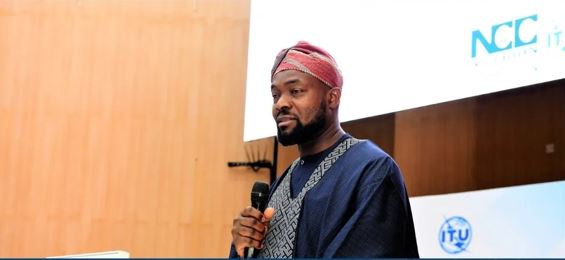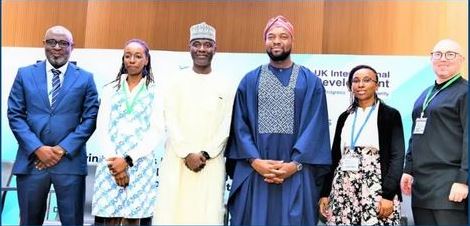International Telecommunication Union (ITU) Collaborative Regulation Report on Nigeria was launched on Tuesday in Abuja by the Honorable Minister of Communications, Innovation and Digital Economy, Dr. Bosun Tijani. This report was prepared by the ITU with support from the FCDO, and in collaboration with the Nigerian Communications Commission (NCC). The ITU Collaborative Regulation Report on Nigeria reviews Nigeria’s collaborative approach in the regulation of ICT. A section of the report treated extensively Nigeria’s journey to G5 regulation and digital transformation and proffer some future steps for consideration. Independent News Express takes an excerpt of this section.
This section revisits the key themes explored in this report and proposes the steps that the NCC and its stakeholders can take to strengthen coordination and collaboration, to improve the readiness of legal, policy and governance frameworks and to facilitate digital transformation in Nigeria. The following steps may be carried out in parallel:
Step 1: Promote locally driven digital transformation. Market development with a locally relevant developmental impact should be at the forefront of Nigeria’s digital transformation strategy. Areas that could be considered for intervention include the promotion of local hosting of cloud services, the wider adoption of mobile money, and broader digital financial service innovation and uptake. Improvements in those areas will have an impact across the economy.


Step 2: Provide policy certainty and predictability. A long-term policy framework will help to create certainty for policymakers, regulators, and market players alike. This needs to be complemented by a keen focus on associated implementation plans for such a framework, the legal and regulatory instruments supporting it, and a reduction in legal and regulatory lags. Certainty and predictability will be enhanced by
: • Development of long-term policies: As noted in section 4, Nigeria’s national economic, digital, and ICT policy frameworks are clear and robust, however, they tend to be short- to medium-term and currently extend to 2030. Consideration should be given to developing a longer term, for example a 30-year national plan and digital agenda, to guide the medium-term strategies.
• Constant and consistent implementation monitoring and evaluation. Once the policy framework is in place, there is a need to focus on policy implementation to ensure impact.63 Implementation needs to be measured through effective monitoring and evaluation frameworks, which includes reporting and public accountability. Nigeria’s broadband penetration at 45 per cent is still 25 percentage points short of its target, which it wants to meet within the next three years, and successful implementation of the national broadband plan will be crucial to drive digital transformation. Similarly, adopting strategies to reduce the digital divide will be critical, such as the 2022 strategy for leveraging agent networks to drive women’s financial inclusion.
. • Reducing policy and regulatory lag: Policy and regulatory instruments should be up to date and keep up with market developments. In order to reduce regulatory lag, the drafting and promulgation of legislation and regulations that support existing policy in a timely manner is important. A number of key medium-term policies have lapsed (2020) or are due to come to an end in the next two years. Notwithstanding the impact of COVID-19 and the recent national elections, it is important that these policies are updated, and their implementation reviewed to ensure their success. NITDA has reported that it has taken steps to put in place frameworks to facilitate e-health, e-education and data protection, but awareness of these is limited, even amongst affected stakeholders and these are yet to be formally promulgated. Delays and/or overlaps will only serve to reduce the impact and potential relevance of these policy and regulatory instruments.
Step 3: Maintain a high level of regulatory maturity in the fast-evolving digital environment. In order for NCC to lead the required collaboration effectively, it needs to be sufficiently mature and agile. As discussed in section 5, regulatory maturity can be measured by regulatory independence and accountability, transparency and predictability, expertise, proactivity, and future orientation, as well as by a wide network of collaborating agencies delivering concrete solutions to ICT and digital market challenges. Nigeria’s NCC fairs well in terms of its maturity and is encouraged to continue to manage the ‘basic’ telecommunication regulatory processes and standards that it mastered on its path to G4 regulation, such as transparent public consultation processes, impact analysis and research.
Step 4: Enhance the quality of collaboration. Strategic partnership and collaboration is a key pillar in the NCC vision implementation plan (SVIP) and its strategic management plan (SMP). The implementation of this pillar, and the facilitation of inter- and cross-sector collaboration by NCC has been confirmed by interviews carried out in support of this research. It is further evidenced by the formal and semi-formal relationships that exist across institutions. Notwithstanding this inter-agency collaboration, it is important to note that the international benchmarks in section 2 (Table 1) generally place Nigeria’s performance in the third quartile. This implies that while in many instances substantial steps have been taken to collaborate, the depth and quality of collaboration between regulators and with other stakeholders needs to continue to improve. This will strengthen the shift from consultation to collaboration and will improve implementation outcomes. In addition, it is crucial to be mindful of the digital ecosystem and the roles that various institutions play in it. Nigeria needs to be flexible and forward looking to take full advantage of the emerging benefits brought about by ICTs and digital transformation.
Step 5: The institutional frameworks should support role clarity, policy coherence, and lean governance. While responsibility for digital transformation at the federal level is shared between the Federal Ministry of Communications and Digital Economy agencies (such as NCC, NBC, and NITDA), there are a large number of other government agencies that impact digital transformation and e-government implementation, which leads to issues of responsibility overlaps and ineffective coordination. In instances where there are overlaps, gaps or a lack of clarity, as in the case of NCC and NITDA, there is a need to clarify uncertainty, take steps to reduce forum shopping, and address ineffective policy implementation.
The findings of this report are aligned with the World Bank Nigeria Digital Economy Diagnostic Report that recommended improvements to the legal framework to streamline overlapping responsibilities between agencies, both horizontally in the ICT sector, and vertically between state and national levels, and improve coordination at a policy level.64 To facilitate this, it is recommended that there is a focus on two key issues.

1. Coordination between the different agencies that govern ICT policy, regulation, and implementation can be achieved through the merger of agencies where the overlap warrants it, or when external factors and trends, such as convergence, necessitate it. The potential merger of NCC and NBC is one such example. Where there is not enough similarity between institution mandates to warrant a merger, the establishment of formalized inter-ministerial and inter-agency structures, such as the National Broadband Infrastructure Joint Committee and the Joint Tax Board, would be a useful means to facilitate coordination.
2. Coordination at the national level is important where there is a wide variation of institutional arrangements, particularly evident in Nigeria, and where the objective is to facilitate a digital economy. Linkages between federal and state level institutions and between sector specific ministries, departments and agencies are necessary for an effective and outcome-driven collaborative governance framework to exist.
The example set by the Edo State model, where a stand-alone ICT agency has been established with responsibility for overseeing state level implementation, and which reports to the Governor in a way that aligns with national policy, has been found to be very effective. This model could be considered for adoption by other states.
Step 6: Expand collaboration and create new partnerships. Whole-of-government collaboration and cooperation should be encouraged as described in the ITU GSR-21 Best Practice Guidelines65. For many agencies, a more formal engagement could be considered where NCC currently has informal or non-existent collaborative relationships. These institutions and other stakeholders could be considered as future partners. In addition, consideration should be given to:
• Collaboration with ministries of health and education could be improved and strengthened through a more formal engagement mechanism than is currently in place between NCC and these ministries.
• At a sector-specific level, it should be recognized that IT and digitization knowledge lie better with NITDA (and more broadly the ICT ministry), however the subject matter expertise resides with the relevant ministry or agency that has little ICT knowledge. This should be acknowledged and reflected in how sector ICT strategies are developed and implemented, with ministries and NITDA setting up collaborative structures co-led by the two institutions. With regard to the implementation of the new e-health policy and the e-education policy developed by NIDTA, practical next steps to facilitate successful implementation include, ensuring stakeholder buy-in, increasing awareness across government and other stakeholders, and in the case of education, the relevant agencies developing further sub-policies to support the ICT in education policy.
• Collaboration between NCC and the transport regulatory authority, energy regulatory authority and the postal regulation authority is currently minimal, and increasing collaboration opportunities should be considered. For example, collaboration and/ or coordination will strengthen the response to innovations such as e-hailing and communications technologies that require the evolution of traditional postal services. In addition, collaboration will enable a proactive and supportive approach to innovation that occurs across sectors, again cross-sector regulatory sandboxes could be a good way of facilitating this.
• Federal and state level ICT policy and regulatory authorities could increase their level of collaboration and coordination and, through the Nigerian Governors’ Forum or another mechanism, a way could be found to share lessons learned and best practices between states.
Step 7: Promote innovation: The policy and legal framework should build space for regulatory experimentation and incentives for digital innovation. Where innovation has occurred and new and innovative applications of technology have been evidenced, Nigeria’s regulators across sectors have been faced with challenges. For example, e-hailing services have received mixed policy and regulatory signals from government. Local platforms such as those cutting across sectors or state boundaries require regulatory certainty to thrive and to provide safe services to consumers. Rather than a re-active approach, the approach taken by CBN in developing a sandbox framework may prove useful for other digital services across other sectors of the economy as well. This will facilitate the development of a more deliberate approach to support innovation and to facilitate financing and ultimately market entry by entrepreneurs and small businesses with locally relevant ideas. It is key that a regulatory mindset that facilitates innovation, and the changes that it may bring about, is encouraged.
Step 8: Improve the cybersecurity framework: While various instruments and institutions are in place to combat cybercrime and enhance cybersecurity capacity and capabilities, efforts of different stakeholders need better coordination and communication. The National Cyber Security Policy 2022 prescribes a single national CERT and sector CSIRTs. Only a few sectors specific CSIRTs and focal points are active. This needs to be remedied given the cross-sector impact of cyber-crime.
Step 9: Develop detailed plans or roadmaps for digital skills and adoption. A total ecosystem approach should be taken to drive digital transformation. While high-level policies to facilitate digital skills and to encourage broadband usage and uptake are in place in Nigeria, these are not sufficient for effective implementation. The national digital economy policy and strategy clearly identified a digital literacy and skills pillar and an indigenous content, development, and adoption pillar that would both facilitate the achievement of the goal of a 95 per cent digital literacy level by 2030. However, detailed plans are needed to give effect to this goal, and where they already exist monitoring and evaluation is critical. Supporting policies, such as the NITDA draft national digital literacy framework (2022) should have buy in from all affected ministries, agencies and departments and be quickly followed by detailed implementation plans monitored by the relevant institutions.
Read full report at https://www.itu.int/hub/publication/d-pref-them-33-2023

